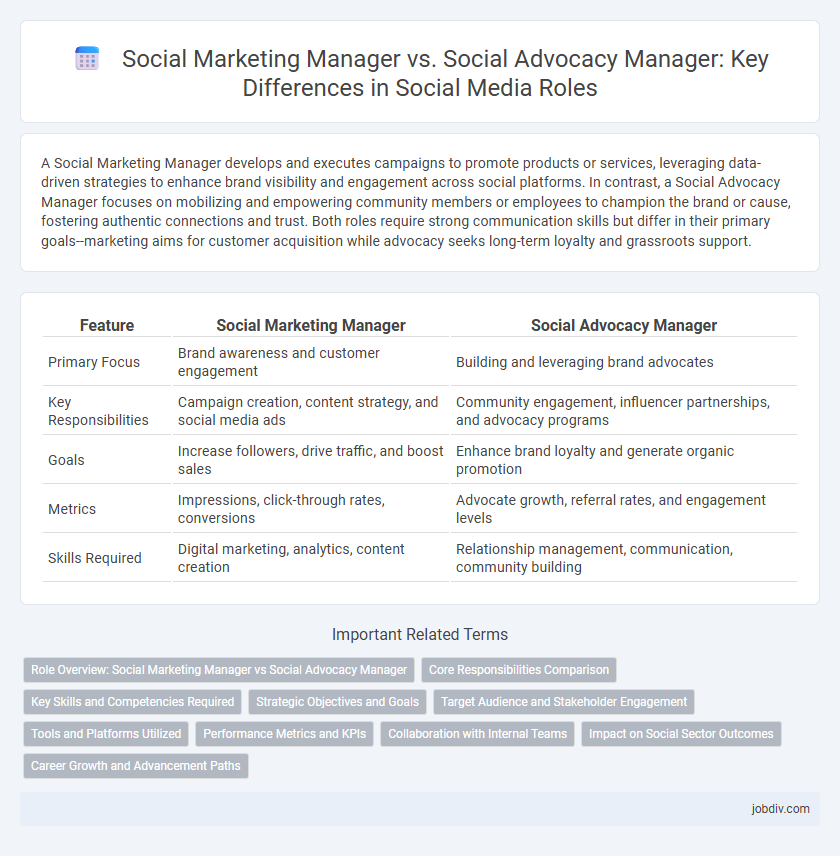A Social Marketing Manager develops and executes campaigns to promote products or services, leveraging data-driven strategies to enhance brand visibility and engagement across social platforms. In contrast, a Social Advocacy Manager focuses on mobilizing and empowering community members or employees to champion the brand or cause, fostering authentic connections and trust. Both roles require strong communication skills but differ in their primary goals--marketing aims for customer acquisition while advocacy seeks long-term loyalty and grassroots support.
Table of Comparison
| Feature | Social Marketing Manager | Social Advocacy Manager |
|---|---|---|
| Primary Focus | Brand awareness and customer engagement | Building and leveraging brand advocates |
| Key Responsibilities | Campaign creation, content strategy, and social media ads | Community engagement, influencer partnerships, and advocacy programs |
| Goals | Increase followers, drive traffic, and boost sales | Enhance brand loyalty and generate organic promotion |
| Metrics | Impressions, click-through rates, conversions | Advocate growth, referral rates, and engagement levels |
| Skills Required | Digital marketing, analytics, content creation | Relationship management, communication, community building |
Role Overview: Social Marketing Manager vs Social Advocacy Manager
Social Marketing Managers focus on crafting and executing strategies to enhance brand presence and drive customer engagement through targeted social media campaigns. Social Advocacy Managers prioritize building and nurturing community relationships, encouraging user-generated content and authentic brand endorsements to amplify social influence. Both roles require expertise in digital communication, but the Social Marketing Manager leans towards promotional content creation, whereas the Social Advocacy Manager centers on fostering trust and advocacy within social networks.
Core Responsibilities Comparison
A Social Marketing Manager develops and executes campaigns to promote brand awareness and drive customer engagement through diverse social media channels, leveraging data analytics to optimize content performance. In contrast, a Social Advocacy Manager focuses on building and managing relationships with brand advocates and influencers, fostering community support to amplify authentic word-of-mouth marketing. Both roles require strategic communication skills, but the Social Marketing Manager prioritizes broad audience reach, while the Social Advocacy Manager centers on cultivating loyalty and grassroots promotion.
Key Skills and Competencies Required
A Social Marketing Manager excels in data-driven campaign development, audience segmentation, and performance analytics, requiring proficiency in digital marketing tools and strategic content creation. A Social Advocacy Manager demonstrates strong community engagement, influencer relationship building, and grassroots mobilization skills, emphasizing emotional intelligence and persuasive communication. Both roles demand adaptability, creativity, and a deep understanding of social media algorithms to effectively influence target demographics.
Strategic Objectives and Goals
Social Marketing Managers focus on developing campaigns aimed at promoting products or services to drive brand awareness and increase customer engagement through targeted messaging and analytics. Social Advocacy Managers prioritize building and nurturing relationships with brand advocates and influencers to amplify positive word-of-mouth and foster community trust and loyalty. Both roles align strategically to enhance brand reputation, but Social Marketing emphasizes direct consumer conversion while Social Advocacy targets organic, peer-based promotion.
Target Audience and Stakeholder Engagement
A Social Marketing Manager targets a broad consumer audience to drive brand awareness and customer acquisition through tailored campaigns across multiple social media platforms, focusing on metrics like engagement rate and conversion. In contrast, a Social Advocacy Manager concentrates on engaging existing brand advocates and employees to amplify authentic voices, fostering trust and loyalty within niche communities and internal stakeholders. Effective stakeholder engagement for Social Advocacy Managers involves cultivating strong relationships with key influencers and brand ambassadors to create a sustained advocacy network that complements marketing efforts.
Tools and Platforms Utilized
Social Marketing Managers primarily utilize tools like HubSpot, Hootsuite, and Google Analytics to design campaigns, manage content calendars, and track engagement metrics across platforms such as Facebook, Instagram, and LinkedIn. Social Advocacy Managers focus on employee advocacy platforms like EveryoneSocial, Dynamic Signal, and Smarp to mobilize and measure brand ambassadors' social sharing, fostering authentic promotion and extended reach. Both roles rely on data-driven insights but apply them through different software suites tailored to their strategic objectives within social media ecosystems.
Performance Metrics and KPIs
Social Marketing Managers prioritize performance metrics such as engagement rate, click-through rate (CTR), conversion rate, and return on ad spend (ROAS) to measure campaign effectiveness and brand awareness. Social Advocacy Managers focus on KPIs like employee advocacy participation, shares per post, sentiment analysis, and advocacy-driven lead generation to evaluate brand loyalty and community impact. Both roles leverage data analytics tools but differ in metrics by targeting marketing outcomes versus community-driven influence.
Collaboration with Internal Teams
A Social Marketing Manager collaborates closely with content creators, analytics teams, and product managers to design campaigns that drive brand awareness and customer engagement. A Social Advocacy Manager works primarily with HR, employee engagement, and communications teams to foster authentic brand storytelling through employee voices. Both roles require seamless teamwork to align social strategies with overall business objectives and enhance the brand's social presence.
Impact on Social Sector Outcomes
Social Marketing Managers design targeted campaigns to influence behavior changes, driving measurable improvements in public health, environmental sustainability, and community engagement. Social Advocacy Managers mobilize stakeholders to promote systemic policy reforms, enhancing social justice and equity on a broader scale. Both roles are critical in shaping social sector outcomes through strategic communication and community empowerment.
Career Growth and Advancement Paths
A Social Marketing Manager typically advances by honing expertise in campaign strategy, analytics, and brand growth, often progressing to roles like Director of Marketing or Chief Marketing Officer. In contrast, a Social Advocacy Manager focuses on community engagement, stakeholder influence, and policy alignment, with career growth leading to positions such as Advocacy Director or Chief Communications Officer. Both roles offer distinct advancement paths shaped by their core skills: performance-driven marketing versus mission-driven advocacy.
Social Marketing Manager vs Social Advocacy Manager Infographic

 jobdiv.com
jobdiv.com